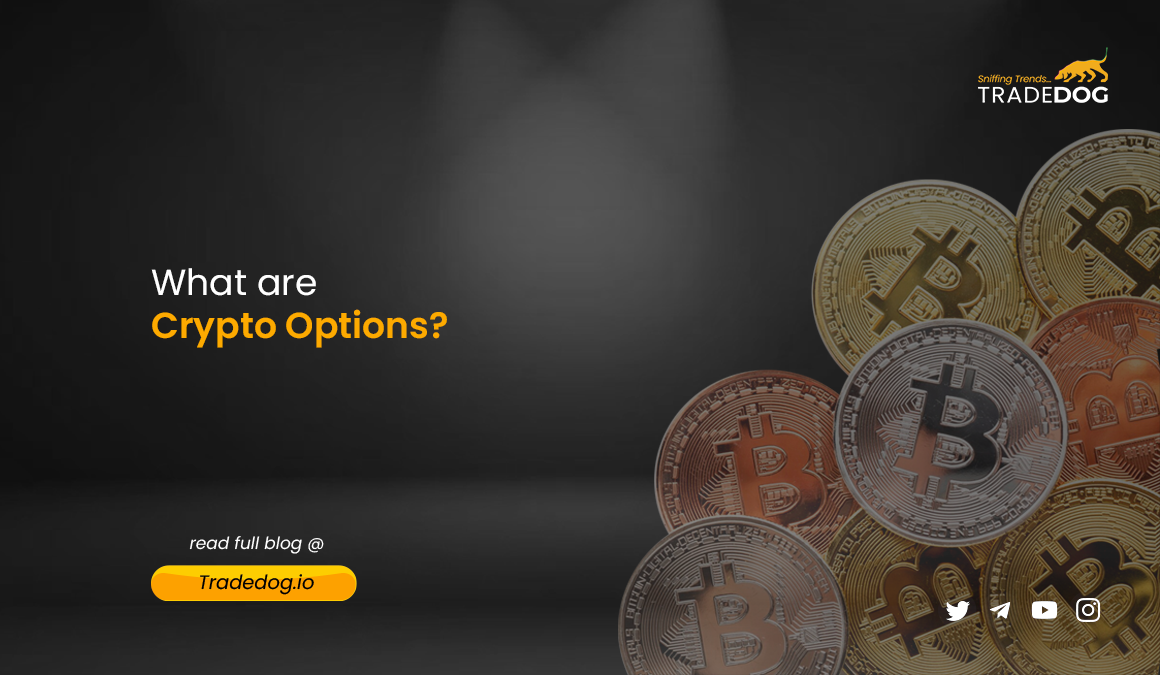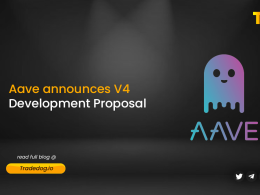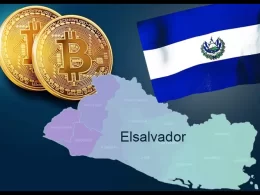Quick Links
As the cryptocurrency market continues to evolve and mature, traders are constantly seeking innovative ways to manage risks and capitalize on opportunities. Amidst the volatility and unpredictability inherent in the crypto landscape, traditional investment strategies may fall short. This is where crypto options trading emerges as a crucial tool, offering a solution to the complexities of crypto investing while unlocking new avenues for profit generation.
Crypto options trading represents a sophisticated approach to investing in cryptocurrencies without directly owning them. At its core, it involves entering into contracts that grant the buyer the right, but not the obligation, to buy or sell a specified amount of cryptocurrency at a predetermined price and time. Unlike traditional spot trading, where ownership of the asset is necessary for participation, options trading provides flexibility and mitigates risk exposure. As of the latest data, the combined Open Interest (OI) for Bitcoin and Ethereum options stands at approximately ~$26.6Bn, and the total options volume for Bitcoin and Ethereum has reached approximately ~$58.5Bn.
How does it work?
In crypto options trading, traders can purchase call options if they anticipate a price increase or put options if they expect a decline. These options are structured around key elements such as strike price, expiration date, and premium. The strike price denotes the agreed-upon price at which the asset can be bought or sold, while the expiration date signifies the timeframe within which the option must be exercised. Premiums, paid by the buyer to the seller, represent the cost of the option.
Here is a detailed version of how it works:
Contract Creation
Crypto options trading begins with the creation of contracts between two parties – the buyer (also known as the holder) and the seller (also known as the writer). These contracts outline the terms of the option, including the underlying asset, strike price, expiration date, and premium.
Underlying Asset
The underlying asset in crypto options trading is typically a cryptocurrency such as Bitcoin (BTC) or Ethereum (ETH). The buyer of the option does not directly own the underlying asset but rather gains the right to buy (in the case of a call option) or sell (in the case of a put option) the asset at a predetermined price.
Types of Options
- Call Option: This type of option gives the buyer the right, but not the obligation, to buy the underlying asset at a specified price (strike price) before or at the expiration date.
- Put Option: Conversely, a put option grants the buyer the right, but not the obligation, to sell the underlying asset at a predetermined price before or at the expiration date.
Strike Price
The strike price, also known as the exercise price, is the price at which the underlying asset can be bought or sold upon the option’s exercise. It is a crucial component of the option contract and is determined at the time of contract creation.
Expiration Date
Options contracts have a finite lifespan, known as the expiration date. This is the date by which the option must be exercised or it becomes worthless. Expiration dates can vary, ranging from days to months, depending on the contract’s specifications.
Premium
The premium is the price paid by the buyer to the seller for the option contract. It represents the cost of purchasing the right to buy or sell the underlying asset at the agreed-upon strike price. The premium is influenced by various factors, including the current market price of the underlying asset, volatility, and the time remaining until expiration.
Exercise
Options can be exercised by the buyer at any time before or at the expiration date, depending on the type of option. If the option is profitable for the buyer, they may choose to exercise it and execute the buy or sell transaction at the predetermined strike price.
Settlement
After the option is exercised, settlement occurs, where the buyer and seller fulfill their obligations as outlined in the contract. Settlement can be physical, where the actual underlying asset is exchanged, or cash-settled, where the option’s value is settled in cash based on the difference between the asset’s market price and the strike price.
Market Dynamics
Throughout the life of the option, its value fluctuates based on various factors such as changes in the underlying asset’s price, market volatility, time decay (the erosion of an option’s value as it approaches expiration), and implied volatility (market expectations of future price fluctuations). Traders analyze these factors to make informed decisions about buying, selling, or holding options contracts.
Terms Related to Options Trading
To navigate the complexities of options trading effectively, familiarity with key terminologies is paramount. Let’s delve into these terms in detail:
- Call Option: A call option is a contract that gives the buyer the right, but not the obligation, to purchase the underlying asset at a predetermined price (strike price) within a specific timeframe.
- Put Option: A put option is a contract that grants the buyer the right, but not the obligation, to sell the underlying asset at a predetermined price (strike price) within a specific timeframe.
- Strike Price: The strike price, also known as the exercise price, is the price at which the underlying asset can be bought (for call options) or sold (for put options) upon exercise of the option.
- Expiration Date: The expiration date is the date on which the options contract expires and becomes worthless if not exercised. It dictates the timeframe within which the option must be exercised.
- Premium: The premium is the price paid by the buyer to the seller for the option. It reflects the cost of purchasing the option contract and is influenced by factors such as volatility and time to expiration.
- In-the-Money (ITM): An option is considered in-the-money when the current market price of the underlying asset is favorable for the buyer to exercise their right to buy or sell the asset.
- Out-of-the-Money (OTM): Conversely, an option is considered out-of-the-money when the current market price of the underlying asset is not favorable for the buyer to exercise their right to buy or sell the asset.
- Time Decay: Time decay, also known as theta, refers to the loss of value in an option contract as it approaches its expiration date. Options lose value over time due to the diminishing probability of the option being exercised profitably.
- Implied Volatility: Implied volatility is a measure of the market’s expectation of future volatility in the underlying asset, as reflected in the option’s price. It indicates the market’s perception of the asset’s potential price movements.
- Options Greeks: Options Greeks are financial measures that quantify the sensitivity of an option’s price to various factors, including changes in the underlying asset’s price, volatility, time, and interest rates.
- Delta: Delta measures the change in the option’s price about changes in the underlying asset’s price.
- Gamma: Gamma measures the rate of change of delta in response to changes in the underlying asset’s price.
- Theta: Theta measures the rate of decline in an option’s value over time.
- Vega: Vega measures the sensitivity of an option’s price to changes in implied volatility.
- Intrinsic Value: The intrinsic value of an option is the difference between the strike price and the current market price of the underlying asset. It represents the value that would be realized if the option were exercised immediately.
- Time Value: Time value, also known as extrinsic value, is the portion of the option’s premium that exceeds its intrinsic value. It reflects the value attributed to the time remaining until expiration and the potential for the option to become profitable.
Top 5 Common Options Strategies
Covered Call
A covered call involves owning the underlying asset and simultaneously selling a call option on that asset. This strategy is typically employed when the trader expects the asset’s price to remain relatively stable.
Protective Put (Married Put)
The protective put strategy involves purchasing an asset and simultaneously buying a put option on that asset.
Protective Collar
The protective collar strategy combines owning the underlying asset with simultaneously purchasing a put option and selling a call option.
Long Call Spread
A long call spread involves buying call options at a specific strike price while simultaneously selling an equal number of call options at a higher strike price.
Long Put Spread
The long put spread strategy entails buying put options at a specific strike price while simultaneously selling an equal number of put options at a lower strike price.
.
Best Crypto Options Trading Platforms
| Exchange | Options Available | Trading fees | Locations | Open Interest |
| Binance | BTC, ETH, BNB, XRP, DOGE | 0.03% transaction fee, 0.015% exercise fee | Global, excluding the US | $7.2Bn |
| Bybit | BTC, ETH | 0.02% trading fee, 0.015% delivery fee, 0.2% liquidation fee | Global, excluding the US | $4.6Bn |
| OKX | BTC, ETH | Tiered maker/taker fees and trading fees | Global, excluding the US | $2.9Bn |
| Deribit | BTC, ETH | 0.03% of the underlying | Global, excluding the US | $2.2Bn |
| BitMEX | BTC, ETH (limited contracts) | Up to 0.75% maker fee, up to 1% taker fee | Globally (excluding certain jurisdictions) | $345.5Mn |
Benefits of Crypto Options Trading
Limited Risk
With options trading, traders can limit their risk exposure. Unlike spot trading, where losses can be unlimited if the market moves against the trader, options trading allows traders to define their maximum potential loss up front.
Hedging
Options can serve as powerful hedging tools for managing risk in a crypto portfolio. By purchasing put options, traders can protect their downside risk in the event of adverse price movements in the underlying asset.
Flexibility
Options trading offers traders flexibility in terms of trading strategies and risk management. Traders can choose from a wide range of options strategies, including bullish, bearish, and neutral strategies, depending on their market outlook and objectives.
Leverage
Options trading enables traders to control a larger position in the market with a relatively small amount of capital. This leverage amplifies potential returns, allowing traders to generate higher profits compared to spot trading with the same initial investment.
Diversification
Crypto options trading allows investors to diversify their portfolios beyond traditional spot trading by incorporating options contracts into their trading strategies.
Analysis of Crypto Options
The crypto options market presents an intriguing situation with a ~$26.6Bn Open Interest (OI) indicating moderate activity and a ~$58.5Bn of options Volume showcasing high liquidity. While the moderate OI suggests a cautious or neutral overall sentiment, the high volume paints a different picture.
This could be due to active short-term speculation where traders are making frequent bets without a clear long-term direction. Alternatively, traders might be waiting for a stronger market signal before placing larger directional bets. This combination of high volume and moderate OI could be a sign of a market coiling up, potentially leading to increased volatility or a breakout in either a bullish or bearish direction soon.
Comparison
Crypto Options vs. Crypto Futures
| Feature | Crypto Options | Crypto Futures |
| Contract Type | Agreement to buy/sell at a specific price by a certain date (Right, not obligation) | Agreement to buy/sell at a specific price by a certain date (Obligation) |
| Risk | Limited to premium paid | Unlimited (losses can exceed initial investment) |
| Complexity | More complex with various strategies | Simpler – Long/Short positions |
| Hedging | More flexible for hedging strategies | Limited hedging capabilities |
| Margin | Typically lower margin requirement | Higher margin requirement |
| Profit Potential | Profits capped (up to difference between strike price and market price minus premium) | Profits can be unlimited |
| Market Sentiment | Can be gauged through Open Interest (OI) analysis | Limited ability to gauge market sentiment |
Crypto Options vs. Equity Options
| Feature | Crypto Options | Equity Options |
| Underlying Asset | Cryptocurrency (e.g., Bitcoin, Ethereum) | Stock (shares of a public company) |
| Volatility | Generally more volatile | Less volatile than crypto markets |
| Regulation | Less regulated market | More regulated market |
| Options Pricing | Higher premiums due to higher underlying volatility | Lower premiums due to lower underlying volatility |
| Liquidity | Can vary depending on the specific option | Generally more liquid markets |
| Hedging Strategies | Can be used for hedging other crypto holdings | Primarily used for hedging stock positions |
Risks of Crypto Options Trading
High Volatility
Cryptocurrency markets are highly volatile. This volatility introduces a significant risk for options traders, as sharp price swings can result in substantial losses, especially if the market moves against the trader’s position.
Lack of Regulation
The cryptocurrency market is still relatively young and largely unregulated compared to traditional financial markets. This lack of regulation exposes options traders to various risks, including potential fraud, market manipulation, and security breaches on trading platforms.
Limited Liquidity
Some crypto options markets may suffer from limited liquidity which can lead to slippage and difficulty exiting positions, especially for large orders. Low liquidity can also result in wider bid-ask spreads, reducing trading efficiency and increasing trading costs for options traders.
Complexity
Options trading can be complex and involves a steep learning curve, especially for novice traders. Understanding options terminology, pricing models, and various trading strategies requires time and effort.
Counterparty Risk
Traders are exposed to the risk that the other party in the trade may default on their obligations. This risk is particularly relevant in over-the-counter (OTC) options markets, where trades are conducted directly between counterparties without the oversight of a centralized exchange.
Conclusion
Crypto options trading represents a dynamic and lucrative avenue for investors seeking to navigate the ever-changing landscape of cryptocurrencies. By harnessing the power of options contracts, traders can effectively manage risk, capitalize on market movements, and diversify their portfolios. However, success in options trading demands a comprehensive understanding of its mechanics, diligent research, and prudent risk management. With the right knowledge and approach, crypto options trading can unlock a world of opportunities for savvy investors.









